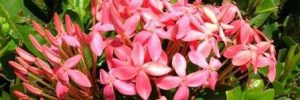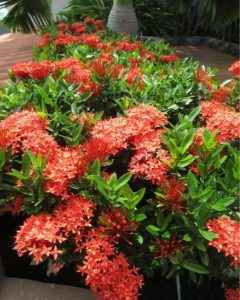By Tommy Clarkson from the December 2013 Edition

(Ixora chenensis)
Family: Rubiaceae
(Also known as Jungle Geranium, Mexican Geranium, Jungle Flame, West Indian Jasmine, Needle Flower, Chinese Ixora and Flame of the Woods.)
For a plant lover such as me, my initial comment, regarding the Ixora, may seem a bit fickle. But, we are all human and, accordingly, each of us has our own likes and dislikes, favorites and those not so. So with that said . . . I admit to being not altogether, wildly crazy about this tropical evergreen shrub! (Patty, however, loves their bright, happily massed, large clusters of four-lobed flowers!)
From my perhaps, somewhat, jaded perspective it’s a nice, functional, reasonably practical, bush that well serves certain purposes. However, it lacks the “stun power” of a large, magnificent Bismarck Palm, strident brilliance of a Bird of Paradise or eye popping splendor of a healthy vining growth of Passion Flower blooms.
It’s simply your “average Joe” of the botanical world . . .but lest I recognize it there is a solid place for such!
With that preceding caveat, I must give it its proper due. As it sports nearly year around clustering, flower blooms (fullest during the rainy season) in a variety of colors red and orange most common it is used as a hedge, screen, garden border or specimen plant. Pink, yellow and white varieties are also available. One of the white colored Ixora finlaysoniana is small tree native to Thailand with large, fragrant flowers.
This family of around 500 species range from Africa, Asia, and Australia to the South Pacific Islands and is named after an Indian deity.
In fact, the red species of this plant are commonly used in Hindu worship and, we understand, have long been employed in Indian folk medicines. (Speaking of such, in the “Oh, by the way” category and helpful trivia in case you are ever on “Jeopardy” the name Ixora appears to have been derived from the Sanskrit word “Ikvana”, the earlier mentioned Indian/Malaysian Deity.)
A healthy, multi-branched plant has oblong, dark green, glossy, leathery leaves. In the right environs, it is capable of reaching a height of 3.6 meters (12 feet), but “tamed” they generally grow in the range of one to two and a half meters (3 – 8 feet). There is also a dwarf variety popular as a potted plant and effectively employed in a linear manner on our Transition Terrace.
The Ixora appears to have some medicinal value with the roots being utilized by country folk, in its native terrain, to lesson stomach troubles and cure dysentery. Some claim that an extraction from the flowers or bark can relieve bloodshot eyes and potentially be capable of curing sores and ulcers.


And also, from back a bit, the contrast of colors against the leaves is, in fact, somewhat striking
Like Gardenias, Hibiscus, and Allamanda, the Ixora bush likes acidic soil. These plants require more fertilization management than plants grown in alkaline soils which leads to iron and manganese deficiencies and causes the leaves to become chlorotic (yellowish). So, don’t plant near concrete walls or foundation, among concrete fragments or where it will get runoff from concrete or stucco. Feed the plants up to monthly-water soluble 10-10-6 or high nitrogen fertilizer and use organic mulch which will help lower the soils high pH.
It will tolerate light shade but prefers full sun and is moderately salt tolerant. Only slightly drought tolerant, water it regularly and evenly during warm weather in well drained soil. And, somewhat like a generally shaggy headed acquaintance of mine, an annual pruning is a good thing. Such will keep the plant flowering to an optimum. It is important to avoid the repeated shearing of branches tips, as this removes emerging flower buds. This plant shaping,

And also, from back a bit, the contrast of colors against the leaves is, in fact, somewhat striking
yearly “haircut” should be done in early spring before new growth emerges.
Aphids, mealy bugs and scale insects are its most common pests. Without good control of these critters, sooty mold, the black fungus stemming from their excrement can follow these bugs. Carefully applied late in the day to reduce leaf sunburn damage and by judiciously following the application instructions, one of the better controls is a horticultural oil spray applied weekly for five weeks. Another problem for the Ixora can be Nematodes. To thwart these microscopic soil worms, mulch around the plant just short of against the trunk.
Lastly, two solid reasons to like Ixora: (1) Related to wild coffee, its blossoms attract hummingbirds, butterflies, and bees. And, (2) the national flower of Republic of Suriname another good bit of trivia its colorful blooms can be incorporated in cut flower arrangements.
For back issues of “Roots”, gardening tips, tropical plant book reviews and videos of numerous, highly unique eco/adventure/nature tours, as well as memorable “Ultimate Experiences” such a Tropical Garden Brunches and Spa Services, visit www.olabrisagardens.com .”
Download the full edition or view it online
—
Tommy Clarkson is a bit of a renaissance man. He’s lived and worked in locales as disparate as the 1.2 square mile island of Kwajalein to war-torn Iraq, from aboard he and Patty’s boat berthed out of Sea Bright, NJ to Thailand, Germany, Hawaii and Viet Nam; He’s taught classes and courses on creative writing and mass communications from the elementary grades to graduate level; He’s spoken to a wide array of meetings, conferences and assemblages on topics as varied as Buddhism, strategic marketing and tropical plants; In the latter category he and Patty’s recently book, “The Civilized Jungle” – written for the lay gardener – has been heralded as “the best tropical plant book in the last ten years”; And, according to Trip Advisor, their spectacular tropical creation – Ola Brisa Gardens – is the “Number One Tour destination in Manzanillo”.





You must be logged in to post a comment.